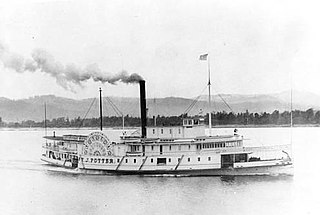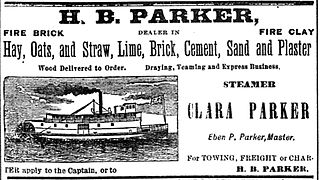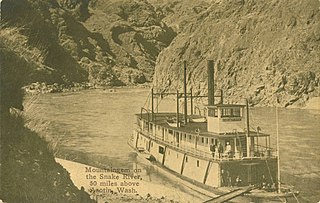
The T.J. Potter was a paddle steamer that operated in the Northwestern United States. The boat was launched in 1888. Her upper cabins came from the steamboat Wide West. This required some modification, because the T.J. Potter was a side-wheeler, whereas the Wide West had been a stern-wheeler. The boat's first owner was the Oregon Railway and Navigation Company. The T. J. Potter was one of the few side-wheeler boats that operated on the Columbia River.

Many steamboats operated on the Columbia River and its tributaries, in the Pacific Northwest region of North America, from about 1850 to 1981. Major tributaries of the Columbia that formed steamboat routes included the Willamette and Snake rivers. Navigation was impractical between the Snake River and the Canada–US border, due to several rapids, but steamboats also operated along the Wenatchee Reach of the Columbia, in northern Washington, and on the Arrow Lakes of southern British Columbia.

The Bailey Gatzert was a famous sternwheel steamboat that ran on the Columbia River and Puget Sound from the 1890s to the 1920s. This vessel was considered one of the finest of its time. It was named after Bailey Gatzert, an early businessman and mayor of Seattle, who was one of the closest friends and business associates of John Leary – the person who financed the ship.
Harkins Transportation Company was founded in 1914 by L.P.(Lovelace Perne) Hosford, Henry L. Pittock, and A.J. Lewthwaite. The line was named after the tugboat Jessie Harkins, which had been built by Jacob Kamm and named after Hosford's niece. The line ran steamboats on the lower Columbia from 1914 to 1937, when it was forced into bankruptcy. Steamboats owned by the company included Georgiana, Lurline, Undine, and Madeline. In 1931, the company built the diesel propeller tug L.P. Hosford, using upper works salvaged from the Lurline.

Lurline was a steamboat that served from 1878 to 1930 on the Columbia and Willamette rivers. Lurline was a classic example of the Columbia river type of steamboat.

R. R. Thompson was a large sternwheel steamboat designed in the classic Columbia River style. She was named after Robert R. Thompson, one of the shareholders of the Oregon Steam Navigation Company, the firm that built the vessel.

Sarah Dixon was a wooden sternwheel-driven steamboat operated by the Shaver Transportation Company on the Columbia and lower Willamette rivers from 1892 to 1926. Originally Sarah Dixon was built as a mixed use passenger and freight vessel, and was considered a prestige vessel for the time.

Montesano was a steamboat that was operated from 1882 to about 1903 in the coastal regions of Oregon and southwest Washington, including Astoria, Willapa Bay, Grays Harbor, the Chehalis River, Yaquina Bay and Coos Bay. The Montesano of 1882, built in Astoria, should not be confused with another, larger sternwheeler, also named Montesano, built-in Cosmopolis, Washington, in 1889.

Shoo Fly was a sternwheel-driven steamboat that operated on the Willamette and Columbia rivers in the 1870s. Originally built as primarily as a freight boat, the vessel was used in other roles, including towing and clearing of snags. Shoo Fly inspired the name of another sternwheeler on the Willamette River, Don't Bother Me.

Dayton was a steamboat which operated on the Willamette and Columbia rivers from 1868 to 1881. Dayton operated on the Willamette from 1868 to 1876, mostly upriver from Willamette Falls, including a route on the Yamhill River to Dayton, Oregon, after which the steamer was named. From 1876 to 1881, Dayton was employed on a run from Portland to Monticello, W.T., which was located on the site of what is now Longview, Washington.

Telephone was a sternwheel-driven steamboat built in 1884 by Captain Uriah Bonsor "U.B." Scott for service on the Columbia River. Reputedly the fastest steamboat in the world in its time, Telephone served on the Columbia River and San Francisco Bay. Telephone was rebuilt at least twice. The first time was after a fire in 1887 which nearly destroyed the vessel. The reconstructed and much larger second vessel was sometimes referred to as Telephone No. 2. The third vessel, Telephone No. 3, built in 1903 and using components from the second steamer was larger but little used during its time on the Columbia river.

Governor Newell was a sternwheel-driven steamboat that operated from 1883 to 1902 in the Pacific Northwest.

Lucea Mason was a steamboat that operated from 1883 to 1891 on the Lewis, Columbia, and lower Willamette rivers. This vessel was occasionally referred to as the Lucia Mason. Lucea Mason was reported to have sunk a lot but nevertheless made a great deal of money for its owners.

Jessie Harkins was a propeller-driven steamboat that operated on the Columbia River in the USA starting in 1903. It was rebuilt at least twice. Originally, Jessie Harkins was one of the larger gasoline-engined vessels to operate on the Columbia River. Jessie Harkins was built for the Harkins Transportation Company.

Joseph Kellogg was a stern-wheel driven steamboat that operated on the Willamette, Columbia, and Cowlitz rivers for the Kellogg Transportation Company. It was named after the company's founder, Joseph Kellogg (1812-1903). The sternwheeler Joseph Kellogg was built in 1881 at Portland, Oregon.

Clara Parker was a sternwheel-driven steamboat which was operated on the lower Columbia and lower Willamette rivers in the 1880s. The steamer ran for about ten years out of Astoria, Oregon in towing and jobbing work. In 1890 Clara Parker was rebuilt and renamed Astorian.

Undine was a sternwheel-driven steamboat that operated from 1887 to 1935 on the Columbia and lower Willamette rivers. From 1935 to 1940 the same vessel was operated under the name The Dalles.

Mountain Gem was a sternwheel-driven steamboat that operated on the Snake and Columbia rivers from 1904 to 1912, when the machinery was removed and installed in a different, newly built steamboat. Mountain Gem remained on the U.S. merchant vessel registry until 1922 or later. Although Mountain Gem was not abandoned until 1924, there is no evidence it was used after 1912.

Telegraph was a sternwheel-driven steamboat built in 1903 in Everett, Washington. Except for the summer of 1905, from 1903 to 1912, Telegraph served in Puget Sound, running mainly on the route from Seattle to Everett, and also from Seattle to Tacoma and Olympia, Washington.

The Callendar Navigation Company, sometimes seen as the Callendar Transportation Company, started in business in the early 1900s. Callendar was formed in the early 1900s, and was based in Astoria, Oregon. Callender was to become one of six large towing companies of the Columbia and Willamette rivers in the early decades of the 1900s, the others being Shaver Transportation, Smith Transportation, Hosford, Knappton Towing Co., and Willamette and Columbia River Towing Co. In 1922, Callendar Navigation merged with Knappton Towboat Co., which existed, with a name change in 1990, and which became part of Foss Marine in 1993.




















